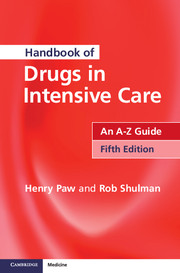Book contents
H
Published online by Cambridge University Press: 05 November 2014
Summary
HALOPERIDOL
A butyrophenone with longer duration of action than droperidol. It has anti-emetic and neuroleptic effects with minimal cardiovascular and respiratory effects. It is a mild α-blocker and may cause hypotension in the presence of hypovolaemia.
Uses
Acute agitation and delirium
Contraindications
QT prolongation, torsades de pointe, ventricular arrhythmias, agitation caused by hypoxia, hypokalaemia or a full bladder
Parkinson's disease
Administration
• IV bolus: 2.5–5 mg
• IV infusion: 30 mg in 50 ml of glucose 5% at a rate of 0–10 mg/h (unlicensed administration)
• IM: 5–10 mg
Up to every 4–8 h
How not to use haloperidol
Hypotension resulting from haloperidol should not be treated with adrenaline as a further decrease in BP may result
Adverse effects
Extra-pyramidal movements
Neuroleptic malignant syndrome (treat with dantrolene)
Prolongation of QT interval
Cautions
Concurrent use of other CNS depressants (enhanced sedation)
Organ failure
CNS: sedative effects increased
Hepatic: can precipitate coma
Renal: increased cerebral sensitivity
Renal replacement therapy
No further dose modification is required during renal replacement therapy
HEPARIN
Uses
Prophylaxis of DVT and PE
Treatment of DVT and PE
Extracorporeal circuits
- Type
- Chapter
- Information
- Handbook of Drugs in Intensive CareAn A-Z Guide, pp. 112 - 118Publisher: Cambridge University PressPrint publication year: 2014



